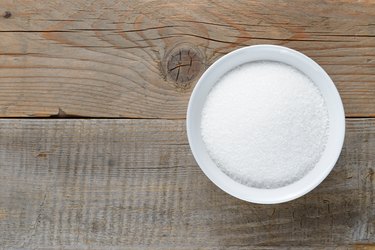Calories In 1 Gram Sugar

Co-ordinate to 2010 dietary guidelines, Americans are consuming too much sugar.
Image Credit: Anatoliy Sadovskiy/iStock/GettyImages
Most cookie and block recipes require a lot of sugar or honey, which tin can hands derail your diet. The calories in a tablespoon of sugar may seem negligible, but can they add together up over time and cause you to pack on pounds. Luckily, there are healthier substitutes for this pop ingredient.
Tip
One tablespoon of sugar has about 48 calories and equals 3 teaspoons. A 20-ounce bottle of cola provides 65 grams of sugar and 260 calories from this ingredient lonely.
Saccharide Calories and Nutritional Value
Added sugar is hidden in thousands of foods and beverages, from desserts to salad dressings and pizza. Brownish sugar, cane sugar, honey, molasses, rice syrup, dextrose and fructose are nothing but sugar in disguise. This sneaky ingredient leaves y'all craving for more and adds empty calories to your meals.
Your trunk doesn't need saccharide to function properly, points out the American Centre Association. Unlike protein, complex carbs and fats, sugar has no nutritional value. It does boost your energy for a short time, but that'due south because it raises glucose levels. Unfortunately, its energizing consequence is followed by crashes.
Whether you prefer kokosnoot sugar, brown sugar or powdered saccharide, the calories in a tablespoon of sugar are the same for all varieties. This food ingredient delivers 4 calories per gram, according to the American Middle Clan and other health organizations.
One tablespoon of carbohydrate equals 12 grams, or three teaspoons. That'southward 48 calories. For example, if your favorite soda has 35 grams of saccharide per serving, that's almost 3 tablespoons or nine teaspoons and 140 calories from sugar alone.
Natural Sugars Versus Added Sugars
One way to cutting downwardly on sugar is to check the food labels and cull appropriately. The trouble is that what's listed every bit "carbohydrate" includes both natural and added sugars, notes the American Heart Association.
Milk and dairy foods, for example, are rich in lactose. Stale, fresh, canned and frozen fruits all contain fructose. Both lactose and fructose are natural sugars. High-fructose corn syrup, dark-brown sugar, dextrose, maltose and fruit juice concentrate, on the other hand, are added sugars. Some manufacturers also use lactose or fructose in their products to enhance their season and texture.
Natural sugars, though, may non exist as harmful as added sugar. High fruit intakes, for instance, have been shown to facilitate weight loss and protect against weight proceeds, according to a review published in the October 2016 bug of the journal Nutrients.
Despite their sugar content, most fruits have anti-obesity effects. They may assistance you maintain a healthy weight by keeping you full longer, balancing your gut flora and reducing your total nutrient intake. Furthermore, they comprise bioactive compounds, including phytonutrients that aid in weight management, as the researchers point out.
Fruit juices have the opposite effect. These beverages accept been found to increase diabetes take a chance by 5 pct in a accomplice study featured in the BMJ in July 2015. Additionally, fruit juice consumption has been linked to higher bloodshed and obesity rates.
As the Nutrients review reports, fruit juices are loaded with sugar and depression in fiber, causing insulin and blood glucose spikes. This may explain their role in diabetes and weight gain. Whole fruits are rich in cobweb, which slows sugar assimilation into your system. Fiber also increases satiety and suppresses hunger, which may contribute to weight loss.
What Near Milk Calories?
As mentioned earlier, milk and its derivatives incorporate a natural saccharide called lactose. Cottage cheese, for example, provides 81 calories and two.one grams of sugar per serving (4 ounces). One cup of skim milk has 83 calories and 12.5 grams of carbohydrate, while yogurt boasts 149 calories and 11.iv grams of sugar per serving (one cup).
Milk calories are negligible, particularly for low-fatty versions. Lactose shouldn't cause any problems unless you're intolerant to it.
In fact, milk and dairy tin brand it easier to maintain your weight, according to a February 2016 large-scale study published in the American Periodical of Clinical Nutrition. Middle-aged and elderly women with the highest dairy intake gained less weight than those who consumed fewer dairy products over the years. Calcium, phosphorus, protein and vitamin D appear to be responsible for the anti-obesity effects of milk.
These findings indicate that natural sugars, such equally fructose and lactose, are less likely to crusade weight proceeds. Added sugar, on the other hand, is associated with diabetes, obesity, insulin resistance and metabolic disorders.
Now that you know more about the calories in a tablespoon of carbohydrate, use this information to make smart food choices. Check nutrient labels for hidden sugars and seek healthier alternatives to your favorite snacks and drinks. Stevia, for instance, can supersede sugar in near recipes and has none of its side furnishings.
Calories In 1 Gram Sugar,
Source: https://www.livestrong.com/article/140464-how-many-calories-are-one-tablespoon-sugar/
Posted by: johnsoncrivair.blogspot.com


0 Response to "Calories In 1 Gram Sugar"
Post a Comment